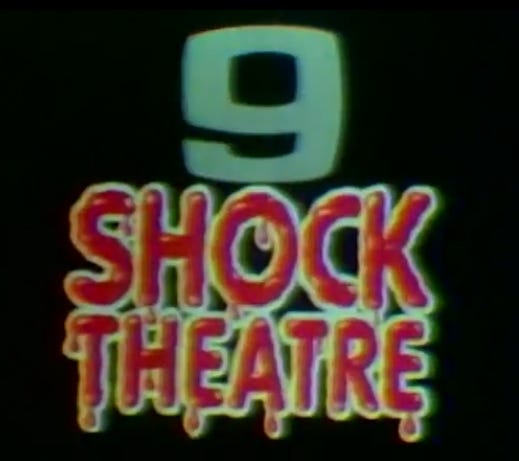Shock! Theatre
When the going gets tough, the tough use a small distributing company to make a bunch of money in the very medium that is ruining their primary business.
In the early 1900s, the only way to watch movies was at a large theater or with a small peep-show box device.
In the post war era, a new technology shook up the media landscape forever: television.
Television was first developed in the 1920s, but the technology was a clunky luxury until the 1940s. The number of television sets in use rose from 6,000 in 1946 to around 12 million by 1951. By 1955, over half of American households had a black and white television set. During this time, middle class Americans also moved to suburbs away from downtown and away from downtown movie theaters.
As a result of all this social shift, film studios started to see their profits drop. Studio executives were scrambling to think of ways to compete with television. One way they did this was by relaxing their production code to allow films to depict racier subject matter.
Another way for film studios to continue making money was to capitalize on the booming medium of television by creating content for TV or licensing existing products to be shown on television. Why should a studio invest in making something new when they could repackage and resell stuff they’d made decades ago. Which brings us to Shock Theatre AKA Shock Theater, AKA Shock!.
In 1957, 52 of Universal Studios’ horror films were released for television syndication for the first time in a package called Shock Theater. A second package, Son of Shock, was released for television by Screen Gems in 1958, with 20 horror films from both Universal and Columbia.
Screen Gems started as M.J. Winkler Productions in 1933. The company started in cartoons, distributing Max and Dave Fleischer’s Out of the Inkwell, Felix the Cat and Walt Disney’s Alice’s Wonderland. Columbia took full controll over the studio in the late 1930s and changed the name to Screen Gems. In the 1950s, Columbia shifted Screen Gems to product television — using the company to hide the fact that Columbia was investing in an industry directly competing with its primary business.
If Screen Gems is familiar to you, it may be because it was the original distributor for Hanna-Barbera Productions.
I found this really wonderful pressbook that Screen Gems sent to tv bookers advertising Shock Theatre. It lists the included films as well as images, factoids, and blurbs to help studios promote the program.
On local markets Shock Theater was hosted by local tv personalities ala Vampira. This television block also introduced another generation to the horror movies of the 1930s and 40s, which helped the films remain in the zeitgeist.
Shock! was huge, boosting viewership in major markets. I think one of the greatest indicators of its impact is that “Shock Theatre” became used as a catch-all term for late night horror movies shown on television. Many local channels also used “Shock” in the titles of their horror programming throughout the 20th century, which makes researching Shock Theater and trying to find archival footage very challenging. Dayton Ohio had a local horror program called Shock Theatre (hosted by Dr. Creep) in the 1970s.
Sources:
Burleigh, S. (2020, July 25). The battle between cinema and television in the 1950s. Medium. https://samuelburleigh.medium.com/the-battle-between-cinema-and-television-in-the-1950s-54656ec3022b
Stephens, M. (1999). History of Television. History of television . https://stephens.hosting.nyu.edu/History%20of%20Television%20page.html
Wikipedia contributors. (2024, July 6). Screen Gems. In Wikipedia, The Free Encyclopedia. Retrieved 20:31, July 8, 2024, from https://en.wikipedia.org/w/index.php?title=Screen_Gems&oldid=1233002963



